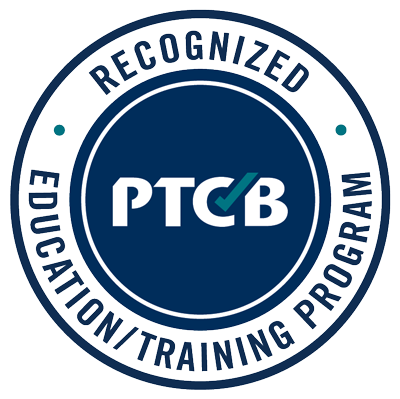
The Smarter Way to Become a Certified Pharmacy Technician
PTCB-Approved online training that adapts to your learning style — with interactive lessons, practice exams, and AI-driven support.
Meet Emma — Your AI Course Guide
Learning online doesn’t have to feel distant. Emma, your AI-powered guide, makes each lesson clear, engaging, and easy to follow.

Learn. Practice. Master.

Short quizzes & Quizlets
Powered by Canvas — trusted by 30M+ learners at 6,000+ institutions. Mobile, accessible, and built for your success.

Full-length practice exam
Test your knowledge with a full-length PTCB practice exam that mirrors the real thing.

Resources & feedback
Learn faster with helpful resources and guidance every step of the way.
Pharmacy Technician Syllabus
- History and evolution of pharmacy practice
- Pharmacy technician duties and scope of practice
- Certification, licensing, and career pathways
- Pharmacy regulatory agencies (FDA, DEA, state boards)
- Drug schedules, controlled substance regulations, and prescription requirements
- HIPAA compliance and patient privacy
- Drug monographs, REMS programs, and prescribing limitations
- Ethical foundations and legal responsibilities
- Overview of dosage forms (oral, topical, injectable, etc.)
- Routes of administration and absorption
- Introduction to pharmacokinetics and pharmacodynamics
- Structure of medical terms (prefixes, suffixes, root words)
- Common pharmacy-related medical terms
- Prescription abbreviations and sig codes
- Interpreting prescription orders and directions
- Refill rules and documentation
- Transfer protocols and communication with other pharmacies
- Retail pharmacy layout and workflow
- Processing prescriptions and billing insurance claims
- Customer service, communication, and professionalism
- Inventory management and non-sterile compounding procedures
- Types of inpatient pharmacies and settings
- Hospital medication orders and medication administration records (MARs)
- Sterile and hazardous drug compounding
- Technician responsibilities in a hospital environment
- Conversions (metric, household, temperature, volume)
- Ratios, proportions, and percentages
- Liquid measurements and dosage calculations
- Concentrations, dilutions, and day supply formulas
- Introduction to drug classifications and the Top 200 drugs
- Cardiovascular System: antihypertensives, statins, anticoagulants
- Nervous System: antidepressants, antiepileptics, analgesics
- Musculoskeletal System: NSAIDs, muscle relaxants, osteoporosis treatments
- Gastrointestinal System: PPIs, antiemetics, laxatives
- Endocrine System: insulin, oral hypoglycemics, thyroid medications
- Respiratory System: bronchodilators, corticosteroids, antihistamines
- Dermatological System: topical antibiotics, antifungals, corticosteroids
- Immune System: antibiotics, antivirals, vaccines, immunosuppressants
- Renal System: diuretics, urinary analgesics, UTI treatments
- Full-length PTCB-style practice exam
- Top 200 drug review tools, charts, and flashcards
- Study guides for law, ethics, and DEA compliance
- Answer keys with rationales for self-assessment and remediation
